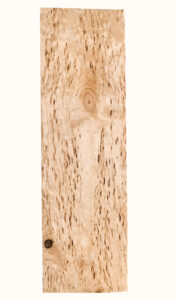Curly birch has a lot of names
In Europe and Scandinavia it’s commonly called curly birch and masur birch. In America, this tree is often called Karelian birch due to its main geographical growth area. Karelian masur birch is often used, and also a -burl appendix is added to the previous names. The „burl“ -suffix is not actually correct, because curly birch pattern resembles a burl.
Various pattern of curly birch
Curly birch patterns vary greatly and can be mainly curly, grainy, birdseye-like or just wavy or flame-like. Often all of these elements are found in the trunk coexisting in a very small piece of wood.
I have noticed that the pattern of younger and thinner trees is rather grainy, and that of thicker trees is more curly. Curly birch’s trunk is not uniformly patterned. Young birches have clearly visible bumps that have markings. The wood between the bumps resembles often a flame or is just white. As the tree grows and the diameter increases, the curly pattern also expands from the bumps. A trunk with about 20cm diameter should already be covered with streaks between the bumps, and the trunk’s wood should be completely covered in patterns. This is provided that the tree has received enough light and the necessary nutrients from the soil.
The price of the Curly birch wood is relatively high
The patterned wood found in the bumps of felled trees is valuable, provided it has a curly pattern and is knot-free. But finding a knot-free birch is a decent challenge, because this tree loves to grow branches! Hence the answer to the question why curly birch is relatively expensive. In order to get decent, patterned wood, the stand owner has to work quite hard.

